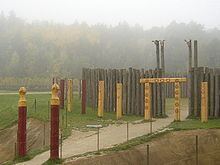 | ||
Rondels mysterious neolithic circular enclosures in central europe
Approximately 120–150 Neolithic earthworks enclosures are known in Central Europe. They are called Kreisgrabenanlagen ("circular ditched enclosures") in German, or alternatively as roundels (or "rondels"; German Rondelle; sometimes also "rondeloid", since many are not even approximately circular). They are mostly confined to the Elbe and Danube basins, in modern-day Germany, Austria, Czech Republic, Slovakia, as well as the adjacent parts of Hungary and Poland, in a stretch of Central European land some 800 km (500 mi) across. They date to the first half of the 5th millennium BC; they are associated with the late Linear Pottery culture and its local successors, the Stroke-ornamented ware (Middle Danubian) and Lengyel (Moravian Painted Ware) cultures. The best known and oldest of these Circular Enclosures is the Goseck circle, constructed c. 4900 BC.
Contents
- Rondels mysterious neolithic circular enclosures in central europe
- Neolithic circular enclosures in central europe
- References
Only a few examples approximate a circular form; the majority are only very approximately circular or elliptic. One example at Meisternthal is an exact ellipse with identifiable focal points. The distribution of these structures seems to suggest a spread from the middle Danube (southern Slovakia and western Hungary) towards the west (Lower Austria, Lower Bavaria) along the Danube and to the northwest (Moravia, Bohemia, Saxony-Anhalt) following the Elbe. They precede the comparable circular earthwork or timber enclosures known from Great Britain and Ireland, constructed much later during c. 3000 to 1000 BC (late Neolithic to Bronze Age). But, by contrast to the long lifetime of the "Megalithic" culture, the time window during which the neolithic Roundels were in use is surprisingly narrow, lasting only for about 200–300 years (roughly 49th to 47th centuries BC).
The earliest roundel to be described was the one at Krpy (Kropáčova Vrutice), Bohemia, by Woldřich 1886, but it was only with systematic aerial survey in the 1980s and the 1990s that their ubiquity in the region became apparent. Three types have been distinguished:
The structures are mostly interpreted as having served a cultic purpose. Most of them are aligned and seem to have served the function of a calendar (Kalenderbau), in the context of archaeoastronomy sometimes dubbed "observatory", with openings aligned with the points sunrise and/or sunset at the solstices. This is the case with the "gates" or openings of the roundels of Quenstedt, Goseck and Quedlinburg. The observational determination of the time of solstice would not have served a practical (agricultural) purpose, but could have been used to maintain a lunisolar calendar (i.e. knowledge of the date of solstice allows an accurate handling of intercalary months).
Known Circular Enclosures:
